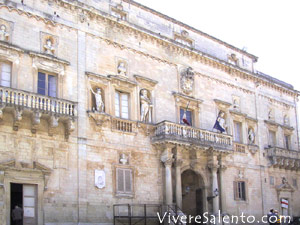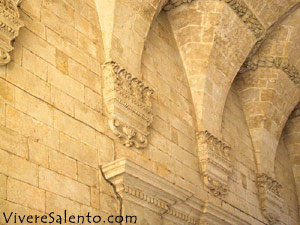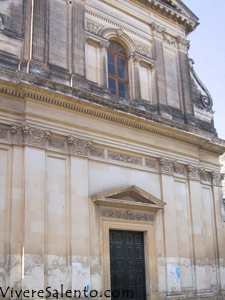|
|

| Inhabitants’name:
Sancesariani
|
The upper part of the
civic coat of arms of San Cesario di Lecce represents the letters "S" and "C,"
while in
 lower
part, on the left, there is a bunch of grapes and on the right two eight
pointed stars. The first inhabited centre probably was built in 237 B.C. during
the Roman domination when the first military settlement was founded at Lecce.
Straight away some houses were built near the military station and new villages
rose. The centre was first called Cesareo, in honour of the Roman emperor
Caesar August. When the Christianisation was brought to this small town, San
Cesario ( a martyr who died in 107 B.C.) became the patron and his name was
given to the village. During the Norman domination the king Tancredi of
Altavilla incorporated the centre into the County of Lecce. Later it passed
under the control of the Principality of Taranto and it was ruled by the Orsini
del Balzos. In 1460 the population increased after the arrival of the Albanians
and Slavs led by the Emperor of the Rumanians, Theodore Eurosio. In 1532 the
feud lower
part, on the left, there is a bunch of grapes and on the right two eight
pointed stars. The first inhabited centre probably was built in 237 B.C. during
the Roman domination when the first military settlement was founded at Lecce.
Straight away some houses were built near the military station and new villages
rose. The centre was first called Cesareo, in honour of the Roman emperor
Caesar August. When the Christianisation was brought to this small town, San
Cesario ( a martyr who died in 107 B.C.) became the patron and his name was
given to the village. During the Norman domination the king Tancredi of
Altavilla incorporated the centre into the County of Lecce. Later it passed
under the control of the Principality of Taranto and it was ruled by the Orsini
del Balzos. In 1460 the population increased after the arrival of the Albanians
and Slavs led by the Emperor of the Rumanians, Theodore Eurosio. In 1532 the
feud was divided into three parts: one was given to the Church of Santa Croce in
Lecce, the second was ruled by Filippo De Matteis and the third one by the
Guarino Family. In 1624 two parts of the feud were bought by the Spanish
Michael Vaaz De Andrada, already Duke of St. Donato. He was a tyrant and the
population rebelled against him. He reacted and made a lot oh houses destroy. In
1703 the village was reunited thanks to the Marullis who bought the whole feud.
They were the last vassals who ruled San Cesario and contributed notably to
better the economic conditions of the small town. At San Cesario there are a lot
of important local people. Giovanni Cipolla lived in the XVIII century and he
was a priest and teacher of theology. Giuseppe Capone lived in the XVIII century
and, after graduating in Law, he
was divided into three parts: one was given to the Church of Santa Croce in
Lecce, the second was ruled by Filippo De Matteis and the third one by the
Guarino Family. In 1624 two parts of the feud were bought by the Spanish
Michael Vaaz De Andrada, already Duke of St. Donato. He was a tyrant and the
population rebelled against him. He reacted and made a lot oh houses destroy. In
1703 the village was reunited thanks to the Marullis who bought the whole feud.
They were the last vassals who ruled San Cesario and contributed notably to
better the economic conditions of the small town. At San Cesario there are a lot
of important local people. Giovanni Cipolla lived in the XVIII century and he
was a priest and teacher of theology. Giuseppe Capone lived in the XVIII century
and, after graduating in Law, he
 became
an excellent lawyer and President of the Civic Court of Lecce. Samuele Pasquali
lived between the XVIII and the XIX centuries and, after graduating in Medicine
in only three years, he became a brilliant doctor. Raffaele Albanese was a
priest and a good theologian, and he lived in humility and charity. Luigi
Cipolla was born in 1766 and was an esteemed lawyer and scholar. He taught Roman
Law in Naples and Lecce, and he wrote a lot of works. Aldo Calò was born in
1910 and he became an appreciated sculptor. He was also appointed Manager of the
Art Institutes in many town and he died when he was 71 years old after getting
several professional successes. Pasquale Cecere was born in 1707 and he was an
esteemed physician. Carlo Barbieri was born in 1910 and was a very good sculptor
and painter. He died when he was just 28 years old. Francesco D' Elia was a
good doctor of the XIX century. became
an excellent lawyer and President of the Civic Court of Lecce. Samuele Pasquali
lived between the XVIII and the XIX centuries and, after graduating in Medicine
in only three years, he became a brilliant doctor. Raffaele Albanese was a
priest and a good theologian, and he lived in humility and charity. Luigi
Cipolla was born in 1766 and was an esteemed lawyer and scholar. He taught Roman
Law in Naples and Lecce, and he wrote a lot of works. Aldo Calò was born in
1910 and he became an appreciated sculptor. He was also appointed Manager of the
Art Institutes in many town and he died when he was 71 years old after getting
several professional successes. Pasquale Cecere was born in 1707 and he was an
esteemed physician. Carlo Barbieri was born in 1910 and was a very good sculptor
and painter. He died when he was just 28 years old. Francesco D' Elia was a
good doctor of the XIX century.
|